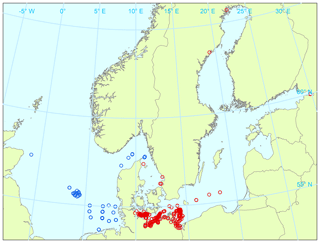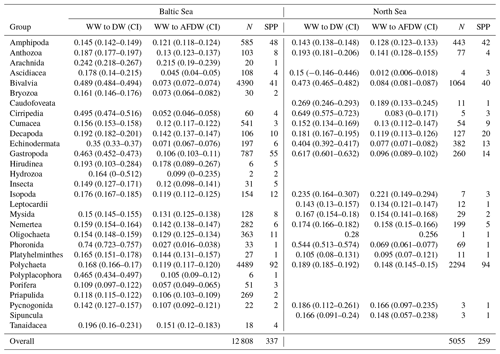Beisiegel, K., Darr, A., Gogina, M., and Zettler, M. L.: Benefits and shortcomings
in the employment of non-destructive benthic imagery for monitoring of
hard-bottom habitats, Mar. Pollut. Bull., 121, 5–15,
https://doi.org/10.1016/j.marpolbul.2017.04.009, 2017.
Brey, T., Müller-Wiegmann, C., Zittier, Z. M. C., and Hagen, W.: Body
composition in aquatic organisms – A global data bank of relationships
between mass, elemental composition and energy content, J. Sea Res., 64,
334–340, 2010.
Gogina M., Zettler, M. L., Vanaverbeke, J., Dannheim, J., Van Hoey, G.,
Desroy, N., Wrede, A., Reiss, H., Degraer, S., Van Lancker, V., Foveau, A.,
Braeckman, U., Fiorentino, D., Holstein, J., and Birchenough, S.:
Interregional comparison of benthic ecosystem functioning: Community
bioturbation potential in four regions along the NE Atlantic shelf, Ecol.
Indic., 110, 105945, https://doi.org/10.1016/j.ecolind.2019.105945, 2020.
Gogina M., Zettler, A., and Zettler, M. L.: Dataset of weight-to-weight
conversion factors for benthic macrofauna of the Baltic and the North Seas,
The Leibniz Institute for Baltic Sea Research, Warnemünde [data set], https://doi.org/10.12754/data-2021-0002-01, 2021.
HELCOM: Manual for Marine Monitoring in the COMBINE, Programme for
monitoring of eutrophication and its effects, Annex C-8, HELCOM, available at: https://helcom.fi/media/documents (last access: 26 April 2021), 2017.
Lappalainen, A. and Kangas, P.: Littoral benthos of the northern Baltic Sea II. Interrelationships of wet, dry and ashfree dry weights of macrofauna in
the Tvarminne area, Int. Rev. Ges. Hydrobiol., 60, 297–312, https://doi.org/10.1002/iroh.19750600302, 1975.
Petersen, G. H. and Curtis, M. A.: Differences in energy flow through major
components of subarctic, temperate and tropical marine shelf ecosystems,
Dana, 1, 53–6, 1980.
R Core Team: R: A Language and Environment for Statistical Computing, R Foundation for Statistical Computing, Vienna, Austria, available at: https://www.r-project.org/ (last access: 23 April 2021), 2021.
Ricciardi, A. and Bourget, E.: Weight-to-weight conversion factors for marine benthic macroinvertebrates, Mar. Ecol. Prog. Ser., 163, 245–251, 1998.
Rumohr, H., Brey, T., and Ankar, S.: A compilation of biometric conversion factors for benthic invertebrates of the Baltic Sea, Balt. Mar. Biolog. Publ., 9, 56 pp., 1987.
Signorell, A.: DescTools: Tools for descriptive statistics. R package version 0.99.41, CRAN [code], https://cran.r-project.org/package=DescTools, last access: 23 April 2021.
Stratmann, T., van Oevelen, D., Martínez Arbizu, P., Wei, C.-L., Liao, J.-X., Cusson, M., Scrosati, R. A., Archambault, P., Snelgrove, P. V. R., Ramey-Balci, P. A., Burd, B. J., Kenchington, E., Gilkinson, K., Belley, R., and Soetaert, K.: The
BenBioDen database, a global database for meio-, macro- and megabenthic
biomass and densities, Sci. Data, 7, 206, https://doi.org/10.1038/s41597-020-0551-2, 2020.
Thorson, G.: Bottom communities (sublittoral or shallow shelf), in: Treatise on marine ecology and paleoecology, edited by: Hedgpeth, J. W., Geol. Soc. Am. Mem., 67, 461–534, 1957.
Tumbiolo, M. L. and Downing, J. A.: An empirical model for the prediction of
secondary production in marine benthic invertebrate populations, Mar. Ecol.
Prog. Ser., 114, 165–174, https://doi.org/10.3354/meps114165, 1994.
WoRMS Editorial Board: World Register of Marine Species, VLIZ, https://doi.org/10.14284/170, 2021.







